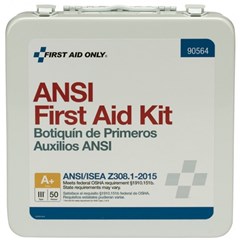LEARN MORE about ANSI/ISEA standards for workplace first aid kits
LEARN MORE about ANSI/ISEA standards for workplace first aid kits

ANSI First Aid Kits
© First Aid Only
The American National Standards Institute (ANSI) makes available numerous standards related to workplace safety in its directory of safety standards, including the recently updated American National Standard ANSI/ISEA Z308.1-2015, Workplace First Aid Kits and Supplies.
ANSI Z308.1 should be viewed as a starting point for an organization’s first aid kit. Many workplaces have job-specific risks that should be addressed on a case-by-case basis with the addition of products necessary to meet those unique needs. The standard tells you what type of kit to use for specific situations and the workplace safety supplies that need to be included in each type of kit.
Two kit Classes: What they mean
A key change in the 2015 revision to the standard is an expansion to help employers determine first aid kit needs for complex work sites. The standard now includes two classes of first aid kits:
-
Class A kits are for the most common workplace injuries, like minor cuts, abrasions and sprains. Class A kits are meant for non-industrial situations with small numbers of people.
-
Class B kits contain more variety and quantity of supplies for injuries that might occur in more complex or high-risk environments.
-
Both classes are designed to deal with common workplace injuries, including major and minor wounds, minor burns, sprains, strains, and eye injuries.
A+ and B+ mean that contents exceed the Class A and B requirements.
With expansion of the items in the basic first aid kit, employees have greater access to items needed to treat common workplace injuries. ANSI/ISEA Z308.1-2015 was developed by ANSI member and accredited standards developer the International Safety Equipment Association (ISEA).
The kit containers are classified by:
-
Portability
-
Ability to be mounted
-
Resistance to water
-
Corrosion and impact resistance
Four kit Types: What they mean
-
Type I: Intended for use in stationary, indoor applications where kit contents have minimal potential for damage due to environmental factors and rough handling. These kits are not intended to be portable and should have a means for mounting in a fixed position. Some applications for Type I first aid kits are general indoor use, office use, or use in a manufacturing facility. First aid cabinets would generally fall into this type.
-
Type II: Intended for use in portable indoor applications where the potential for damage due to environmental factors and rough handling is minimal. These kits should be equipped with a carrying handle. Some applications for Type II first aid kits are general indoor use, or use in office or manufacturing environments.
-
Type III: Intended for portable use in mobile indoor and/or outdoor settings where the potential for damage due to environmental factors is not probable. Kits should have the means to be mounted and have a water-resistant seal. Typical applications include general indoor use and sheltered outdoor use.
-
Type IV: Intended for portable use in mobile indoor and/or outdoor applications where the potential for damage due to environmental factors and rough handling is significant. Typical applications include the transportation industry, utility industry, construction industry and the armed forces.
Back